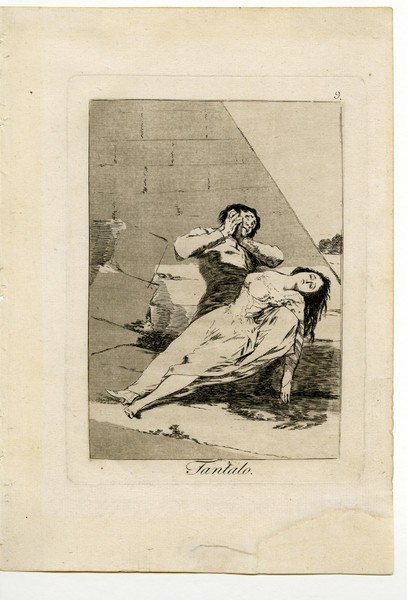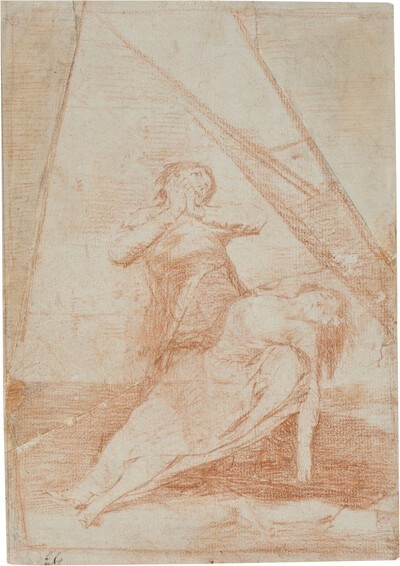- Cronología
- Ca. 1797 - 1799
- Dimensiones
- 210 x 152 mm
- Técnica y soporte
- Etching and burnished aquatint
- Reconocimiento de la autoría de Goya
- Undisputed work
- Ficha: realización/revisión
- 21 Nov 2010 / 29 May 2024
- Inventario
- 225
Tántalo. (at the bottom)
9. (in the upper right-hand corner)
See Francisco de Goya y Lucientes, Painter.
In the Metropolitan Museum of Art in New York there is a proof of state before the handwriting, on which is handwritten and crossed out So that you try? underneath it reads, Tantalum.
A preparatory drawing in sanguine is kept in the Prado Museum.
A man stands in front of a pyramid of which we can only see the base and in which the ashlars that make up the pyramid have been delimited. He clasps his hands in front of his face in a gesture of supplication, while holding the body of a woman on his knees. The woman's torso is uncovered and her breasts are visible, her head is thrown back and her face appears inanimate.
This engraving is somewhat brighter than other prints from Los Caprichos. Goya used aquatint to create the surface of the pyramid, while the male figure's clothing is rendered by etching. One of the main points of light in this picture is the young woman's body, which is partially uncovered at the chest and leg. For this part of the woman's anatomy, Goya used an aquatint so pale and delicately burnished that it is barely visible in the earlier, more inky prints.
The title of this print is an obvious allusion to Greek mythology, in which Tantalus was a son of Zeus and the Oceanid Pluto, who was invited to a banquet by the gods, to whom he responded with another invitation. For them he butchered and cooked his own son, Pelops, which earned him an eternal punishment consisting of lying in a lake with chin-deep water under a tree full of fruit that was removed from his reach whenever he wished to eat. In many cases, scholars have seen in this mythological character the rejection of the Olympian religion of human sacrifice, which was carried out especially in the early cults.
The manuscripts we have preserved explain this engraving by Goya; Ayala's says that "if he were more gallant, she would revive. This happens to old men who marry wenches". In the manuscript of the Prado Museum we can read about this engraving that "if he were more gallant and less fastidious, she would come back to life". Slightly more extensive is the explanation given in the manuscript of the Biblioteca Nacional, which states that "a good female next to an old man who does not satisfy her, has delicacies, is like one who is thirsty, is next to water and cannot taste it".
It is precisely the text in the National Library that leads us to the title of this print, Tantalus, in which Goya criticises unequal marriages that lead to the dissatisfaction of both spouses. He draws a parallel between the condemnation of the mythological character and the circumstances of those who have to satisfy a younger woman, which creates an enormous sense of frustration.
The plate of this engraving is in poor condition ( National Chalcography, no. 180).
-
Goya. Gemälde Zeichnungen. Graphik. TapisserienKunsthalle BaselBasle1953from January 23th to April 12th 1953cat. 201
-
Goya. Das Zeitalter der Revolucionen. Kunst um 1800 (1980 – 1981)Hamburger KunsthalleHamburg1980cat. 24
-
Goya. La década de Los CaprichosMadrid1992organized by Real Academia de Bellas Artes de San Fernando sponsored by Fundación Central Hispano, Madrid, consultant editor Nigel Glendinnig. From October 26th 1992 to January 10th 1993cat.15
-
Francisco de GoyaMuseo d'Arte ModernaLugano1996exhibition celebrated from September 22nd to November 17th.cat. 9, p.36
-
Francisco Goya. Sein leben im spiegel der graphik. Fuendetodos 1746-1828 Bordeaux. 1746-1996Galerie KornfeldBern1996from November 21st 1996 to January 1997cat. 15
-
Das Capriccio als KunstprinzipWallraf-Richartz-Museum,1996from December 8th 1996 to February 16th 1997, exhibited also in Zurich, Kunsthaus, from March 14th marzo 1997 to June 1st 1997 and in Vienna, Kunsthistorisches Museum mi Palais Harrach, from June 29th 1997 to September 21st 1997.cat. G. 38
-
Francisco Goya. Capricci, follie e disastri della guerraSan Donato Milanese2000Opere grafiche della Fondazione Antonio Mazzottacat. 11, p.19
-
Goya e la tradizione italianaFondazione Magnani RoccaMamiano di Traversetolo (Parma)2006consultant editors Fred Licht and Simona Tosini Pizzetti. From September 9th to December 3th 2006cat. 9, p.148
-
Goya. Opera graficaPinacoteca del Castello di San GiorgioLegnano2006exhibition celebrated from December 16th 2006 to April 1st 2007p.24
-
Goya et la modernitéPinacothèque de ParisParís2013from October 11st 2013 to March 16th 2014cat. 132
-
2022
-
Some undescribed states of Goya's CaprichosNew York1945p.179
-
Goya engravings and lithographs, vol. I y II.OxfordBruno Cassirer1964p.79, cat. 44
-
Vie et ouvre de Francisco de GoyaParísOffice du livre1970p.177, cat. 467
-
Goya, la década de los caprichos: dibujos y aguafuertesMadridReal Academia de Bellas Artes de San Fernando1992pp.26-28, cat. 15-16
-
Catálogo de las estampas de Goya en la Biblioteca NacionalMadridMinisterio de Educación y Cultura, Biblioteca Nacional1996p.78, cat. 97
-
El libro de los caprichos: dos siglos de interpretaciones (1799-1999). Catálogo de los dibujos, pruebas de estado, láminas de cobre y estampas de la primera ediciónMadridMuseo Nacional del Prado1999pp.92-95
-
ParísPinacoteca de París2013p. 193
-
Goya. In the Norton Simon MuseumPasadenaNorton Simon Museum2016pp. 42-75
-
Museo de Bellas Artes de Badajoz y Diputación de Badajoz2022p. 32

